A COMPLETE GUIDE TO SURGICAL BLADES IN DENTISTRY AND THEIR APPLICATIONS
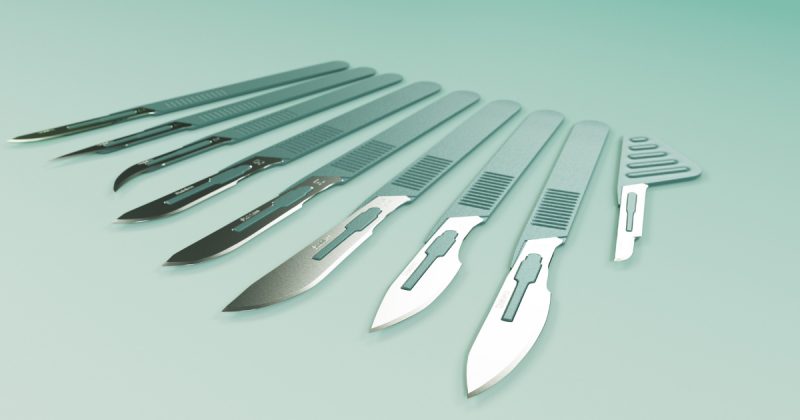
INTRODUCTION
Scalpels or surgical blades are critical devices used by dentists and surgeons in dental procedures, designed to achieve precise incisions and the removal of soft tissue. The blade edges are very sharp, intended for clean cuts and are well controlled to cause minimum damage to the surrounding tissues. This precision is important; it allows faster healing and better outcomes for the surgery.
Surgical blades are made primarily of stainless steel or high-quality carbon steel, which comes in different shapes and sizes. Each shape has been developed for a specific purpose, determined by the type of surgery or the kind of tissue to be treated. The blades are usually attached to handles that provide firm grip and control during surgery.
The selection of the right surgical blade is essential for every procedure, from a soft tissue incision to a more complex surgery like the design of a flap or biopsy. Knowledge of what surgical blades are and how they differ will permit the dentist to work with accuracy and confidence, ensuring patient safety and effective results.
MATERIAL OF SURGICAL BLADES
- Stainless Steel: It is durable, resistant to corrosion, and can withstand multiple sterilizations. Has good sharpness and is one of the most common suture materials.
- Carbon Steel: Very sharp with very good cutting precision; rusts if not properly taken care of. Commonly designed to be disposable blades.
- High-Carbon Stainless Steel: Combines the sharpness of carbon steel with the corrosion resistance of stainless steel, offering a balanced, long-lasting blade.
PARTS OF A SURGICAL BLADE
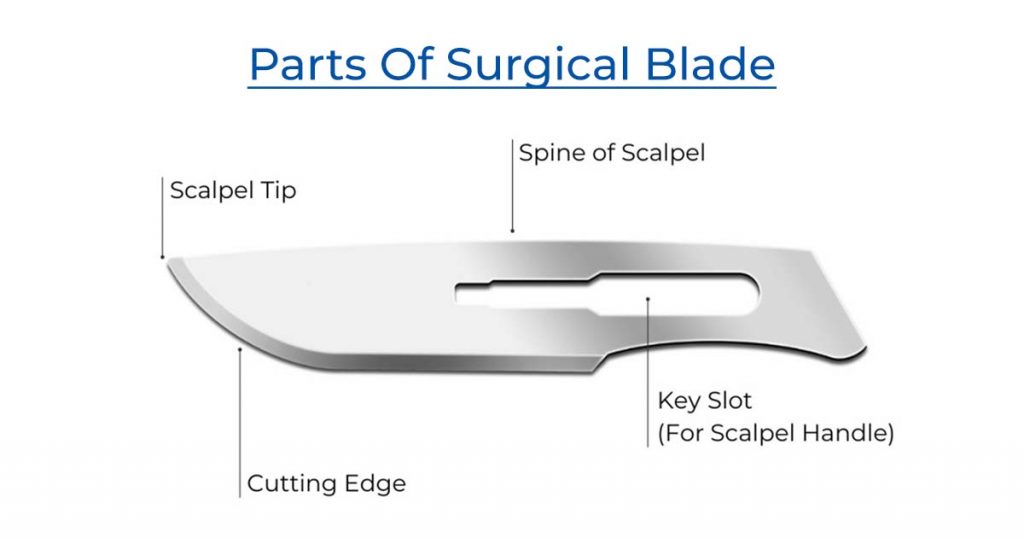
- Cutting Edge: The keenly sharp part of the blade used for making incisions.
- Spine: The thicker, non-cutting upper edge that provides strength.
- Tip: The pointed or rounded end of the blade, which is designed according to the blade shape for specific cutting needs.
- Heel: The back portion of the blade, near the handle attachment.
- Slot (or Tang): The base part of the blade that attaches securely to the scalpel handle.
DIMENSIONS OF SURGICAL BLADES
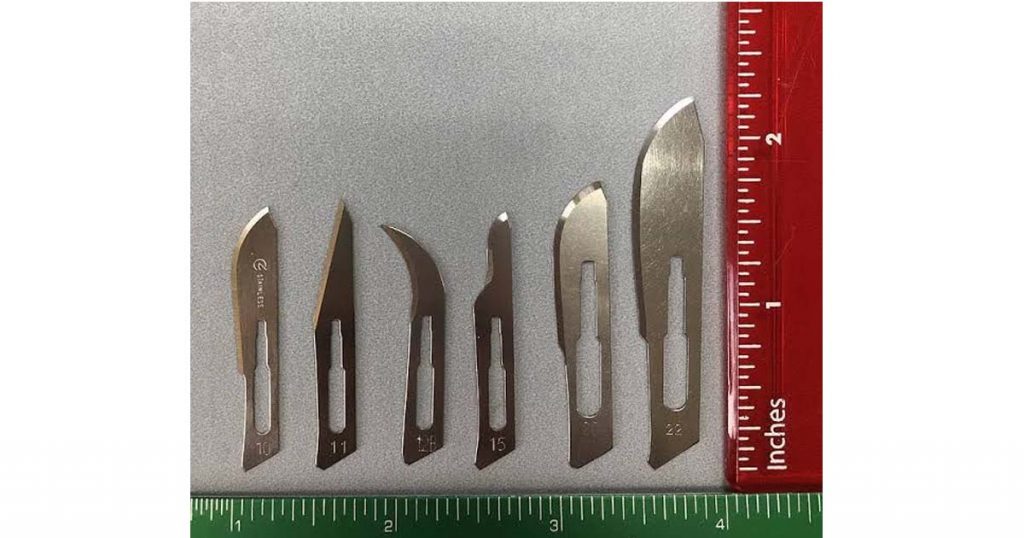
- Length: Varies from small blades (~ 13 mm, e.g., #15 blade) to larger ones (>30 mm, e.g., #20 blade) depending on application.
- Width: The width of the cutting edge generally ranges between 3 to 10 mm; the smallest blades are used for delicate work.
- Thickness: Usually very thin to allow for sharpness but strong enough to resist bending, typically 0.2 to 0.4 mm.

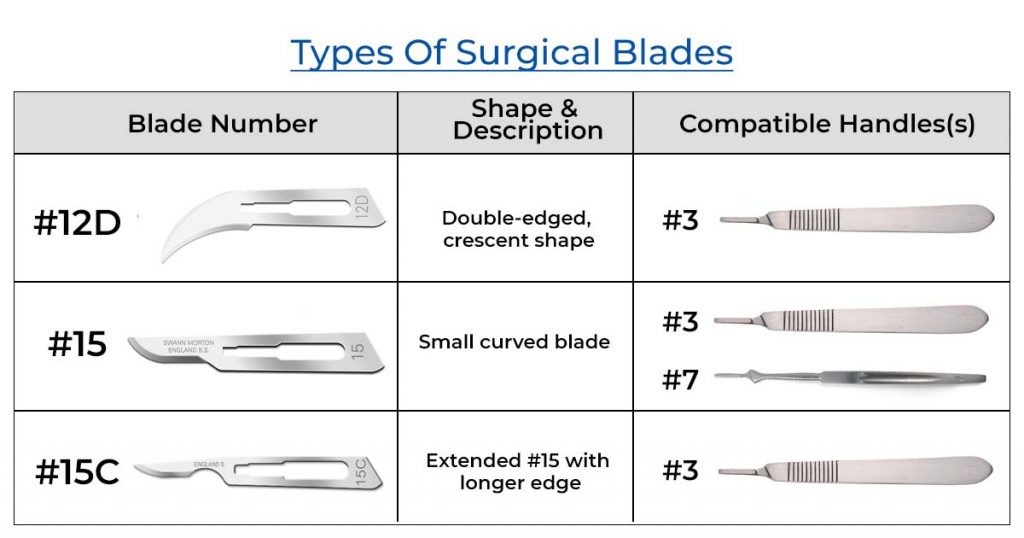
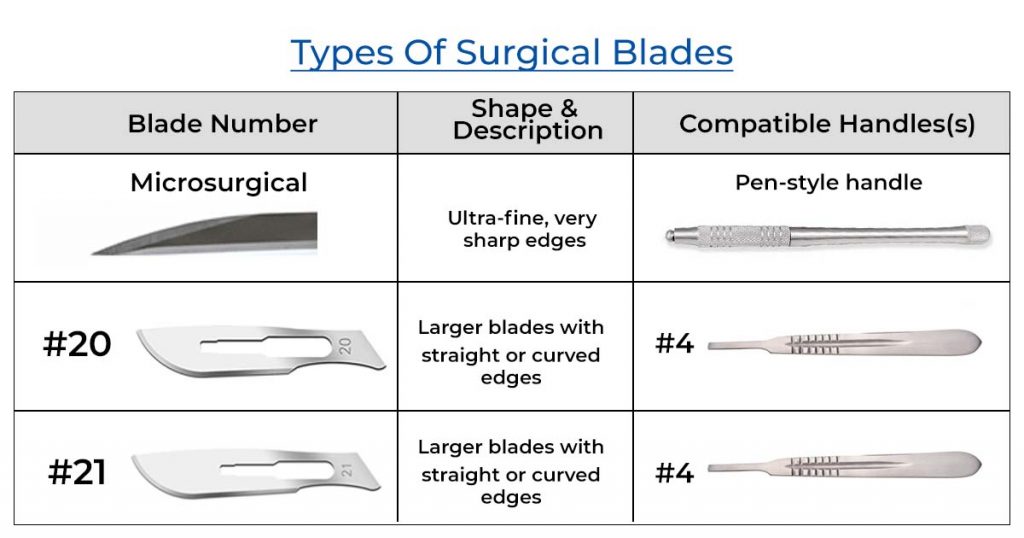
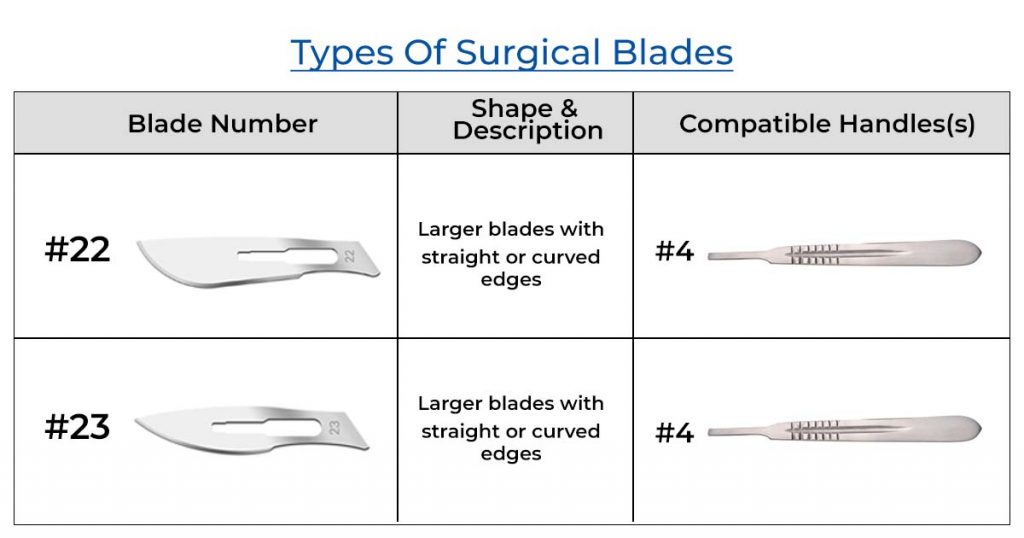
USES AND TECHNIQUE OF SURGICAL BLADES
| Blade Number | Uses | Technique Tips |
|---|---|---|
| #10 | Broad incisions, mucoperiosteal flap elevation in extraction and implant placement | Smooth, continuous strokes for wide cuts |
| #11 | Stab incisions, abscess drainage, precise punctures such as in abscess drainage | Controlled, gentle puncture motions |
| #12 | Gingivectomy, tissue removal from tight spaces | Curved, follow tissue contours carefully |
| #12D | Periodontal surgeries, sulcular incisions | short strokes, follow tissue contours carefully |
| #15 | Fine, short incisions, papilla preservation | Tiny, controlled cuts for delicate tissues |
| #15C | Procedures needing more reach in delicate tissue | Gentle, careful maneuvering in confined areas |
| Microsurgical | Periodontal plastic surgery, microsurgical cases | Light, meticulous handling under magnification |
| Larger blades (#20+) | Large incisions in oral/maxillofacial surgeries | Steady, decisive strokes for heavy tissue work |
How to attach the surgical blade?

SURGICAL BLADE SELECTION & SAFETY GUIDELINES
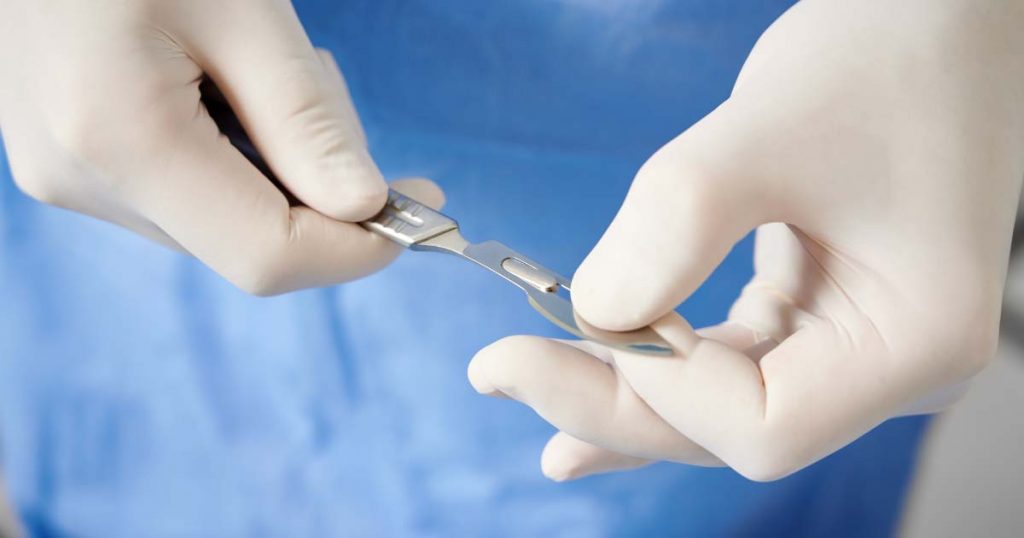
- Match Blade to Procedure: Select blade size and shape for specific surgical procedure—e.g., #10 for broad incisions, #15 for work in delicate tissues.
- Handle Compatibility: The blade should fit into the handle snugly to avoid slipping and ensure control.
- Material Choice: Use stainless steel or high-carbon steel blades depending on the needs for durability and sharpness.
SAFETY PROTOCOLS
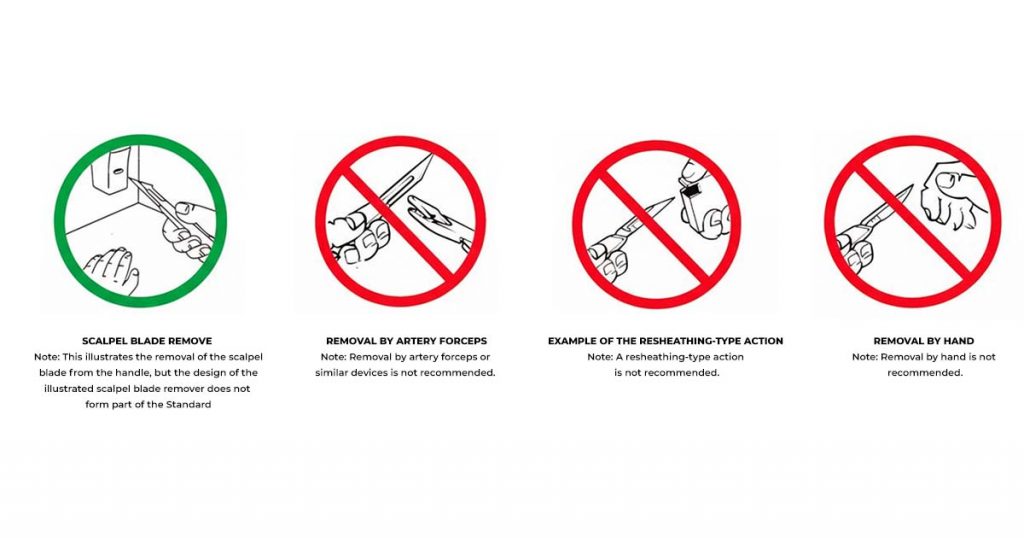
- Sterility: Blades should always be opened just prior to use. Sterile conditions are maintained throughout.
- Handle with Care: Grasp handles securely, and do not apply force too strongly to avoid slippage.
- Proper Mounting: Before using the blade, it should be fastened to its handle.
- Safe Disposal: Dispose of the used blades in the puncture-proof sharps containers after use. Never recap contaminated blades.
- Personal Safety: Wear gloves, eye protection, and follow protocols to prevent injuries from sharp blades.
- Training & Technique: Regularly update skills regarding proper cutting techniques to minimize tissue trauma and protect against needlestick injuries.
MICROSURGICAL BLADES IN DENTISTRY
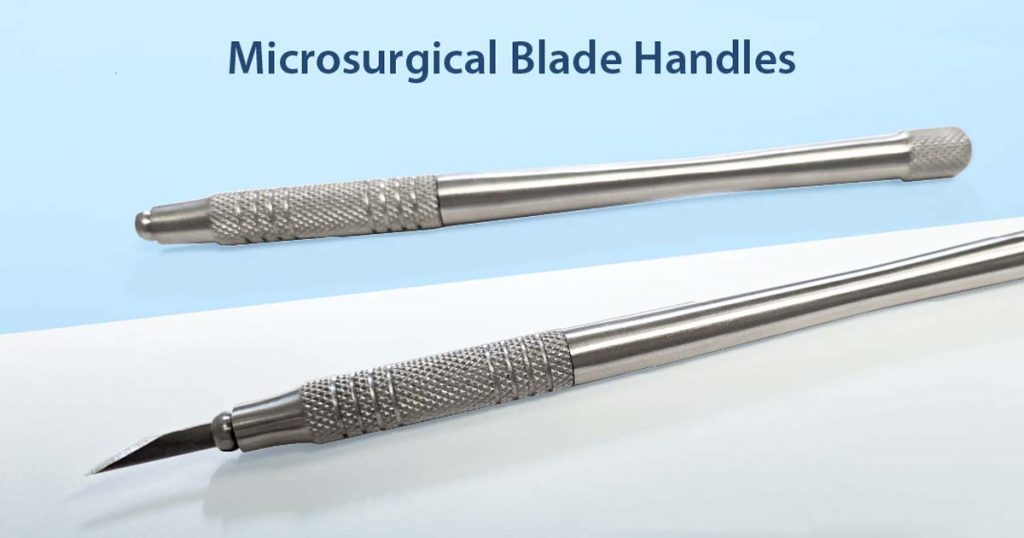
Microsurgical blades with microsurgical handle are used for very delicate procedures in dentistry, including periodontal plastic surgery and tissue grafting. These blades are ultra-fine and allow the clinician to make small, precise incisions with minimal tissue disruption. Such instruments are highly critical in regenerative surgeries, where the concept always remains to preserve as much tissue as possible and accelerate healing. These types of blades are usually used under magnification and require exceptional skill and control.
DISPOSABLE SURGICAL BLADES WITH PRE-ATTACHED PLASTIC HANDLES
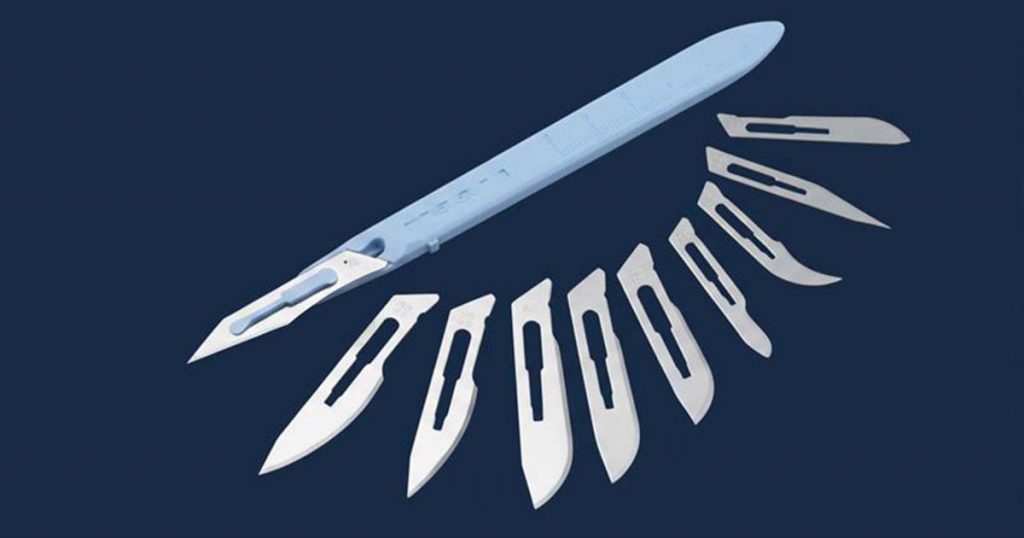
The disposable scalpels with attached handles offer convenience, precision, and hygiene in a single-use design. Each scalpel features a sharp stainless-steel blade permanently fixed to a lightweight, disposable plastic handle. There is no need to assemble the blade or sterilize it because each piece is factory-sterilized by gamma radiation. It comes in an all-in-one configuration that offers maximum sterility and minimizes the risk of cross-contamination. The ergonomic plastic handle is disposable and offers excellent grip and balance, enhancing surgical control and comfort. These ready-to-use scalpels are perfect for minor oral surgeries, soft tissue trimming, and periodontal procedures and find particular application in fast-paced clinical situations where safety, efficiency, and asepsis are prime concerns.
RECENT ADVANCES IN SURGICAL BLADE
They have enhanced the efficiency and accuracy of dental procedures.
- Coated Blades: Advanced coatings on some blades to reduce friction, increase sharpness, and longevity.
- Ergonomically Designed Handles: New handle designs offer better grip and comfort, reducing hand strain during lengthy procedures.
- Sharper Edges: With new manufacturing techniques, even sharper edges are possible that enable finer and more precise cuts with minimal tissue trauma. These advancements make dental surgeries more efficient, with better outcomes for patients.
CONCLUSION
Surgical blades are essential in dental surgeries, as they provide the accuracy and control that allows for successful treatments. By identifying the types of blades, their uses, materials, and proper care, professionals are enabled to optimize surgical outcomes, enhance patient safety, and minimize healing time.
FAQ
Each blade shape and size is designed for a specific task—large, curved blades for broad cuts and smaller, pointed blades for delicate or precise work.
Dentists often use a #15 or #15C blade for fine, short cuts where preserving tissue is important.
These pre‑assembled, single‑use tools maintain sterility and save time by eliminating blade installation and sterilization, making them ideal for quick or minor procedures.
Use stainless steel when you need durability and repeated sterilization and opt for carbon steel when you need an exceptionally sharp edge and plan to dispose of the blade after use.

No Comment